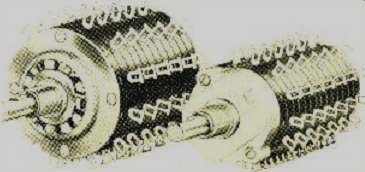By ROBERT H. TILLACK / Electro-Mechanical Products Div., Stackpole Carbon Company

above: The enclosed rotary switches shown here have body diameters of 1 5/8 inches
(left) and 1 1/8 inches, respectively.
THERE is an increasing awareness of the need for enclosed rotary switches in all types of applications. This is especially significant, as contamination plays a major role in determining switch reliability and life, and many atmospheres are inherently contaminating. Performance and reliability will be affected and switch life shortened if operation in such environments is required. The obvious means for protecting the switch against contamination, as has been done for other electronic components, is to isolate it with an enclosure.
In the past, there have been two major deterrents to the use of enclosed rotaries: high cost and limited versatility. The switches shown here have overcome these objections with a unique modular construction that lends itself to automated assembly and versatility. In these devices, the mode of switching has been reversed so that the stator rather than the rotor is cut in varied configurations to accomplish the required switching. The problem of handling a multitude of small parts has been eliminated by using, as a basic building block, a module that is formed by insert-molding a one-piece contact ring in impact-resistant thermosetting plastic. These modules are then cut in varied configurations to accomplish the required switching. Two modules are needed for each deck with a silver-alloy wiper interconnecting the two. Versatility is achieved by (1) varying the cutting of the modules; (2) number of wipers and their positions; and (3) internal interconnection of decks.
The complete enclosure is maintained in the buildup of a multitude of decks, providing an environment-proof assembly. To suit the varied customer requirements, spacers and intersection shields may be incorporated to provide spacing for components and shielding of sections.
Line switches and potentiometers may also be mounted on the rear. One variation even permits the inclusion of a potentiometer internally. Dual concentric shaft switches are also available particularly for use on congested panels.
Some of the areas where enclosed rotaries are finding increasing usage are machine tools, computers, office copy machines, controls and instrumentation for paper mills and chemical factories, vending machines, self-service gasoline pumps, underwater photography and searchlights, and precision instrumentation.
The switches shown here have breakdown voltages of 1000 V a.c. from terminal to terminal and 2000 V a.c. from terminal to ground. The electrical ratings for resistive loads and silver-plated brass contacts are 0.3 A at 125 V a.c. and 0.5 A at 28 V d.c. for the 1 5/8-in switch, and 0.5 A at 125 V a.c. and 1 A at 28 V d.c. for the 15/8-in switch. With silver-alloy contacts, current ratings are about double these values. The standard insulation material used is phenolic, although diallyl phthalate insulation is also available for higher insulation resistance requirements.
The maximum number of switch positions available for the smaller switch is 12, while the larger switch can be obtained with up to 24 positions, either shorting, non-shorting, or mixed.
(source: Electronics World, Oct. 1967)
Also see: Lighted Switching Devices